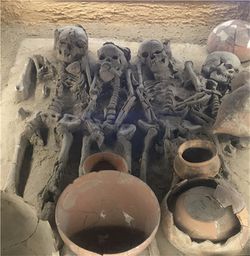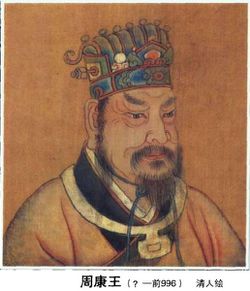How did climate change influence ancient Chinese societies?
Climate does not only sometimes push societies to leave their major cities, which some call collapse, but it also helps societies adjust to a new normal, where food production and even tastes begin to modify based on climate. This is evident in China, where ancient China often did not resemble more recent periods in regards to climate and environmental conditions. Nonetheless, these changes have enriched and brought different layers of social change in Chinese society that have influenced modern China. We can see modern societies are sometimes composed of layers of different past social but also environmental change that forges new social identities.
Rise of Chinese Complex Societies and Climate
During the long Neolithic period in China (from around 8500-2000 BC), as agriculture began to develop, different types of societies and food production practices formed that focused on millet, in western and central China, and rice, which became more common in central and eastern China. In central China, in particular, evidence indicates a shift between millet and rice, where millet is a more hardy crop that can be cultivated in drier periods. In other provinces, there are shifts between rice cultivated in flood agriculture and a mixture of using rice and millet. Both taste and climate-induced changes are likelily co-occurring in the record, where communal and household-based strategies are also shifting in response to social and climate change that co-occurs.
Many of these changes are apparent in central China because it is a region prone or more vulnerable to relatively minor shifts in the climate. Until recent period, millet is seen as the food one can use in periods of stress and drought in China, although now in some quarters millet is a more fashionable food than rice (Figure 1).[1]
Early Bronze Age China, at around 2200 BC, was characterized by widespread flooding according to legend. Yu the Great, a legendary ruler, was purported to help manage the significant flooding that occurred at this time. There is climatic evidence, that by the 4th millennium BCE and going into the 3rd millennium, there were shifts to the monsoon rainfall patterns that agriculture would have become more dependent on. Winter monsoons began to wane in this period, but less predictable rainfall patterns may have resulted, which could have led to greater instances of flooding where rainfall amounts would vary more greatly from season to season rather than occurring in more predictable patterns.
Water management, at this time, began to utilize a series of earthworks, dams, and other irrigation features that likely attempted to mitigate the uncertainty and volatility associated with rainfall. Excess rainfall could be stored or forced into a runoff to avoid catastrophic flooding. This likely helped areas such as along the Yellow River become more controllable and promote settlement along this river valley with greater population concentrations. This has been suggested as helping to give rise to the increased social complexity seen at the end of the third millennium BCE and going into the early dynasties of the 2nd millennium BCE. Effectively climatic shifts could have promoted settlement and increased social complexity as societies adapted to control better and manage less predictable rains.[2]
Chinese Dynasties and Empires
During the Shang Dynasty (1600-1000 BCE), researchers have stated the climate became generally warmer. However, there were periodic cooling and likely drier conditions in eastern China. At around 1100 BC, the Shang became weaker as they had to deal with more harvest failures. However, the Shang could have adapted to this and may have withstood such change. Rather, the Zhou, who conquered the Shang and who lived west of the Shang, may have invaded as they felt their societies faced greater threats due to cooling conditions.
In effect, the invasion and aggressive nature of the Zhou could be attributed to changing conditions that led to more difficult harvests for them. The concept of the Mandate of Heaven, which formulated that a Chinese dynasty should maintain order in the world, including natural order affecting farming and the environment, may have developed at this time as a way to legitimize rulers. It could also be used to blame rulers as climate conditions became more difficult, where rulers of China should upkeep the Mandate of Heaven. This could have happened as the Zhou justified their rule due to the failings of the Shang, as conditions became more difficult.
After the cooling at around 1100 BCE, climate likely returned to more favorable conditions and the Zhou may have become the long-lived dynasty in Chinese history in part due to more favorable conditions. The Zhou portrayed themselves as bringers of stability, where during the 1st millennium BCE climate conditions did generally become stable.[3]

Nevertheless, long-term warmer conditions did last until about 350 CE, covering nearly eight dynasties and ending around the Six Dynasties period. During warmer periods, citrus, such as oranges, may have made their way to China and began to be incorporated into diets. Subtropical herbs and spices were also likely introduced in periods when warmer conditions prevailed, as these plants were more easily grown in northern regions that allowed the major centers of China, such as the city of Chang'an in the Han Dynasty. After 350 CE, much colder conditions became evident in northern China, with much harsher winters. This may have led to the development of ice houses for the first time, which allowed better preservation of food and allowed it to be kept longer. This also likely led tastes in food to change back away from the subtropical foods that could have been grown in other parts of China (Figure 2).[4]
More Recent Climate Change
Overall, over the last two thousand years, the climate has continued the long-term drier and colder conditions in parts of eastern China, where there is evidence this has led to greater evidence for more periodic locust, famine, and drought occurrences. There has also been higher incidents of epidemics when flood conditions become evident, presumably as bacteria thrive better in warmer and moister conditions.[5]
Climate also affected politics over the last two thousand years. The Ming dynasty, lasting until 1644, began to experience greater difficulties in the 16th and early 17th centuries as records show. Peasant rebellions, perhaps triggered by poor harvests, led to the government being defeated and ultimately collapsing. In earlier periods that were more favorable climatically, a military farming system ensured the government's troops were well supplied and provisioned. However, that system began to fail already in the 16th century. During that time, greater military expenditure was required, showing that more money from the central government was needed to ensure the military's readiness. By the early 17th century, the government was in crises as peasants were unable to pay their taxes, which were heavy, to support the increased military expenditures. This loss of revenue was compounded by failed harvests that affected the peasants and government. In effect, a system of military provision had collapsed, forcing the burden on peasants, who themselves were overtaxed and ultimately they revolted against the government that had created the system in the first place.[6]
Summary
Climate has played an important role in Chinese history, from affecting food taste to changing society and leading to rebellion. Climate does not always lead to social collapse, but it can lead to a chain reaction of events that have momentous change. This includes dynasties being created or disease affecting the population. What ancient China shows us is that climate has been a key background element in the evolution of societies, a lesson which we can take to heart in our modern world.
References
- Jump up ↑ For more on food production and shifts in Central China, see: Weisskopf, A., Deng, Z., Qin, L., & Fuller, D. Q. (2015). The interplay of millets and rice in Neolithic central China: Integrating phytoliths into the archaeobotany of Baligang. Archaeological Research in Asia, 4, 36–45.
- Jump up ↑ For more on the rising social complexity and its relationship to water and rainfall, see: Brooke, J. L. (2014). Climate Change and the Course of Global History. West Nyack: Cambridge University Press, pg. 295.
- Jump up ↑ For more on the Shang and Zhou rivalries, see: Marks, R. (2012). China: its environment and history. Lanham, Md: Rowman & Littlefield.
- Jump up ↑ For more on food and technology related to climate, see: Chambers, F., & Ogle, M. (Eds.). (2002). Climate change: critical concepts in the environment. London ; New York: Routledge.
- Jump up ↑ For more on the relationship between climate and epidemics and different events, see: Tian, H., Yan, C., Xu, L., Büntgen, U., Stenseth, N. C., & Zhang, Z. (2017). Scale-dependent climatic drivers of human epidemics in ancient China. Proceedings of the National Academy of Sciences, 114(49), 12970–12975. https://doi.org/10.1073/pnas.1706470114
- Jump up ↑ For more on the Ming dynasty, see: Zheng, J., Xiao, L., Fang, X., Hao, Z., Ge, Q., & Li, B. (2014). How climate change impacted the collapse of the Ming dynasty. Climatic Change, 127(2), 169–182. https://doi.org/10.1007/s10584-014-1244-7
Maltaweel, Admin and EricLambrecht

